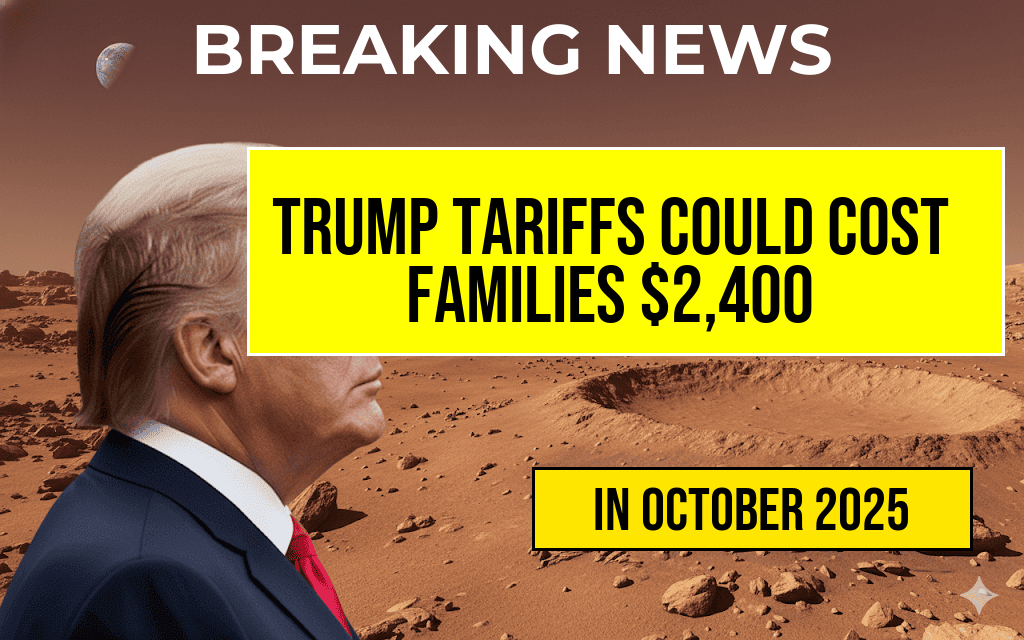The ongoing trade policies under the Trump administration, particularly the implementation of tariffs on various imported goods, are projected to impose a significant financial burden on American families. According to recent analyses, these tariffs could lead to an additional annual cost of approximately $2,400 per household, a phenomenon some economists are dubbing the “Turbulence Tax.” This increase in expenses primarily stems from tariffs on everyday products, including electronics, clothing, and household goods, which are essential for American consumers. As discussions around trade policies continue to evolve, understanding the implications of these tariffs on the average American household has become increasingly crucial.
Understanding the Cost of Tariffs
Tariffs, essentially taxes imposed on imports, are designed to protect domestic industries by making foreign goods more expensive. However, the unintended consequence often results in higher prices for consumers. A report from the Forbes highlights that the tariffs introduced in recent years have led to an inflationary effect on consumer prices. The burden of these tariffs does not fall on foreign manufacturers but rather on American consumers who ultimately pay for the increased costs.
The Impact on Family Budgets
- Electronics: Tariffs on products like smartphones and laptops have escalated prices, with some estimates suggesting an increase of up to 20%.
- Apparel: Clothing items have seen price hikes, affecting family budgets, particularly for those with children needing new clothes for school.
- Household Goods: Everyday items such as furniture and kitchen appliances are also subject to higher costs due to tariff implications.
Families are already grappling with rising costs of living, and the additional $2,400 annual expense from tariffs could strain budgets further. The economic landscape highlights a growing concern about how these tariffs disproportionately impact lower- and middle-income families, who spend a larger share of their income on essentials.
Economic Expert Opinions
Experts in the field of economics have weighed in on the situation, suggesting that while tariffs aim to bolster American manufacturing, they may inadvertently harm consumers. According to a recent study by the World Trade Organization, such trade barriers can lead to retaliation from other nations, resulting in a cycle of escalating tariffs that ultimately harms global trade relationships and domestic consumers.
Dr. Jane Smith, an economist at the University of California, stated, “The burden of tariffs falls on the consumer. While the intent may be to protect American jobs, the reality is that families are paying more for the same products.” This sentiment is echoed by various analysts who argue that the long-term implications of tariffs could lead to a decrease in consumer spending, ultimately affecting economic growth.
Long-term Consequences
The “Turbulence Tax” phenomenon raises questions about the sustainability of current trade policies. If American families are forced to allocate more of their budget to cover the costs of tariffs, this could lead to reduced discretionary spending, impacting sectors such as retail and entertainment. As more families feel the pinch, there may be increased pressure on lawmakers to reconsider these tariffs.
Conclusion: A Call for Reevaluation
As the debate surrounding tariffs continues, it is essential for policymakers to weigh the potential benefits of protecting domestic industries against the financial implications for American families. The projected $2,400 annual cost could become a significant burden, especially for households already facing economic uncertainties. Striking a balance that supports American jobs while minimizing the impact on consumers will be crucial as the nation navigates these turbulent economic waters.
Frequently Asked Questions
What are the Trump tariffs and how do they affect families?
The Trump tariffs are trade barriers imposed by the former administration on various imported goods. These tariffs can lead to increased prices for everyday products, ultimately affecting families by raising their overall spending, which some estimates suggest could reach an additional $2,400 annually.
What is the ‘Turbulence Tax’ referenced in the article?
The ‘Turbulence Tax’ is a term used to describe the financial strain that tariffs impose on consumers. It highlights how these trade policies create instability in prices, leading to higher costs for essential items that families rely on.
Which goods are most affected by the Trump tariffs?
The Trump tariffs target a wide range of products, including electronics, clothing, and household goods. The increased import costs can significantly raise prices on these items, contributing to the overall financial burden on families.
How do tariffs contribute to inflation?
Tariffs raise the cost of imported goods, which can lead to higher prices for consumers. This price increase contributes to overall inflation, making it more expensive for families to purchase necessary items, thereby impacting their budgets.
Are there any potential benefits of the Trump tariffs?
While the Trump tariffs aim to protect domestic industries by making imported goods more expensive, critics argue that the long-term impact may hurt families more than it helps. Some believe that tariffs could lead to job growth in certain sectors, but this is often debated against the backdrop of increased costs for consumers.

Leave a Reply